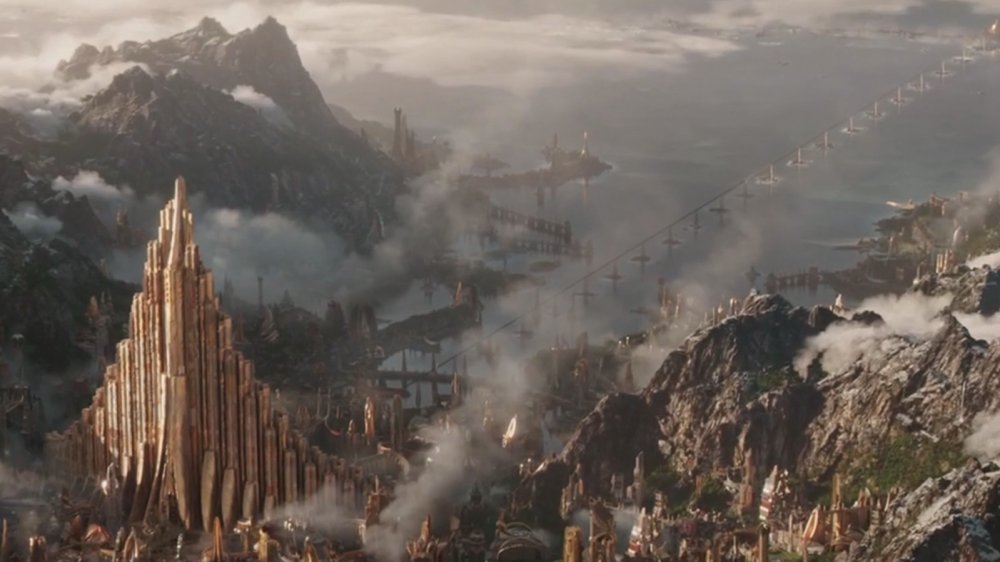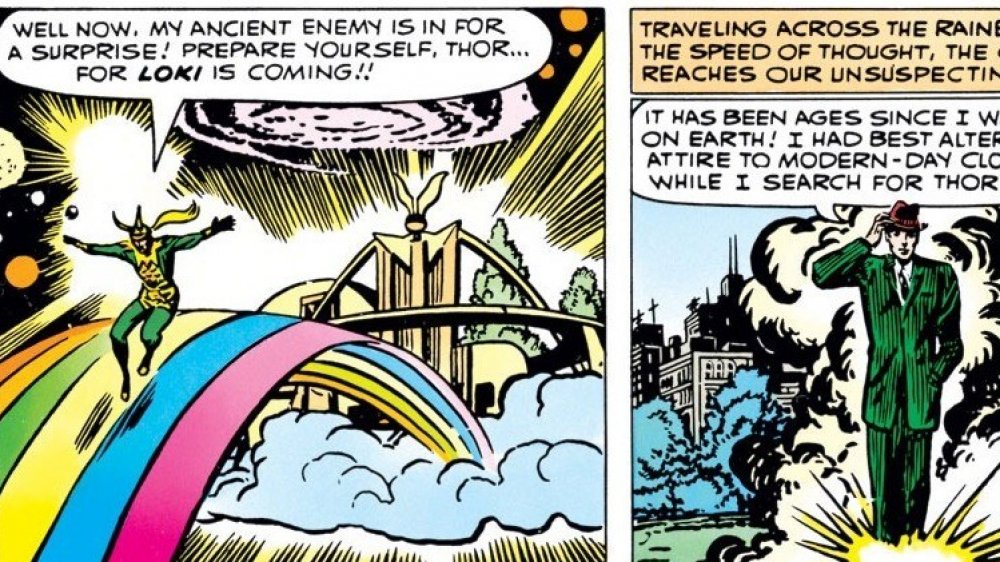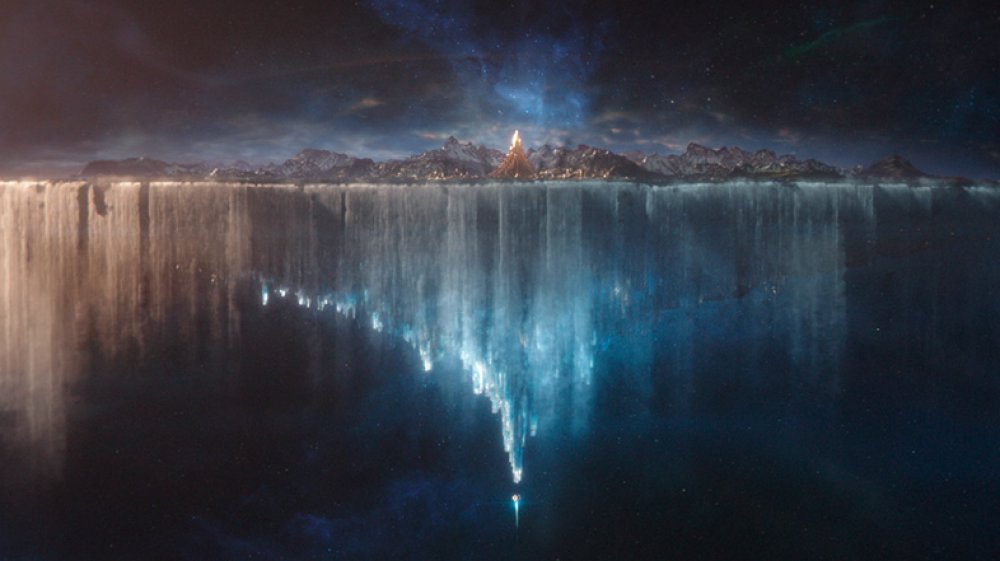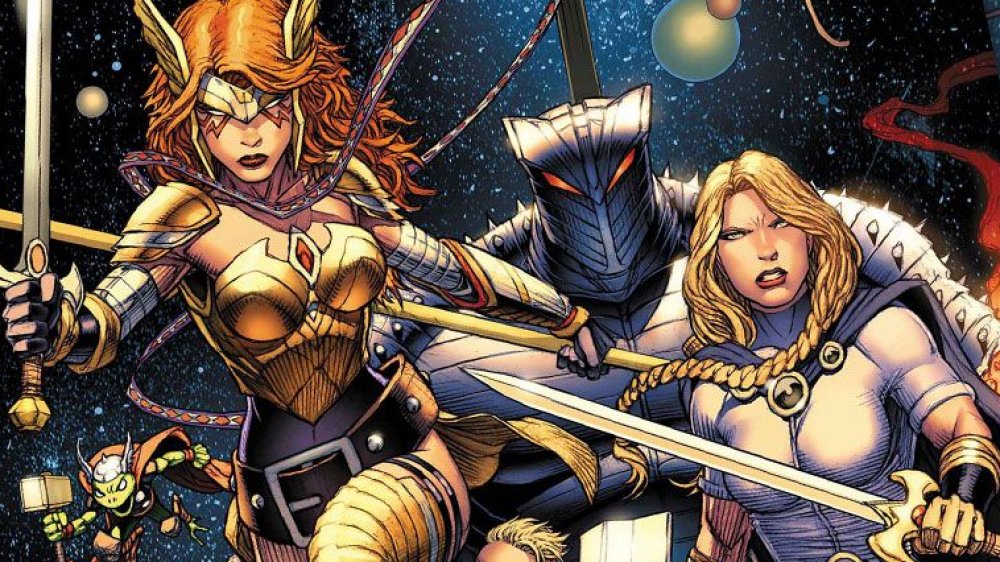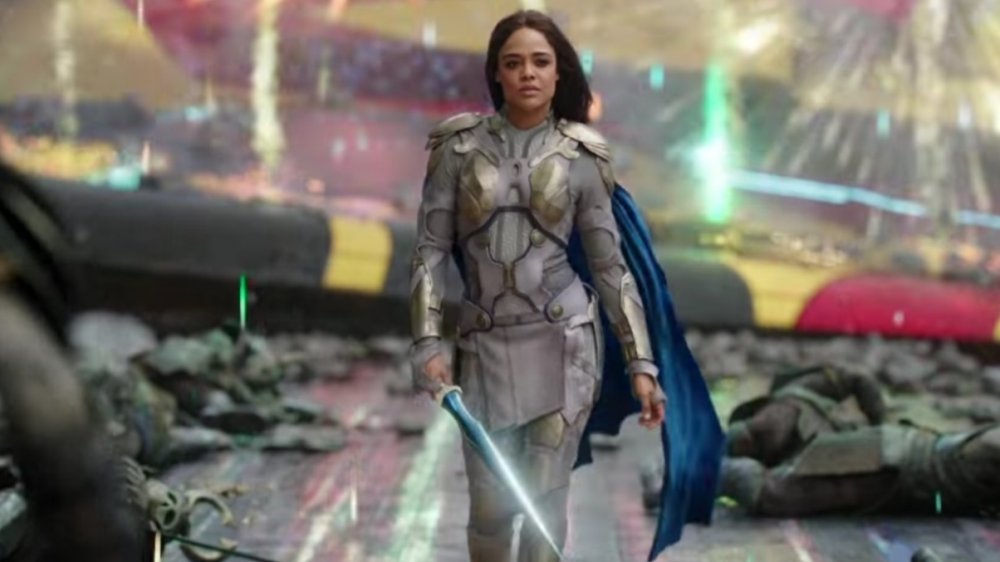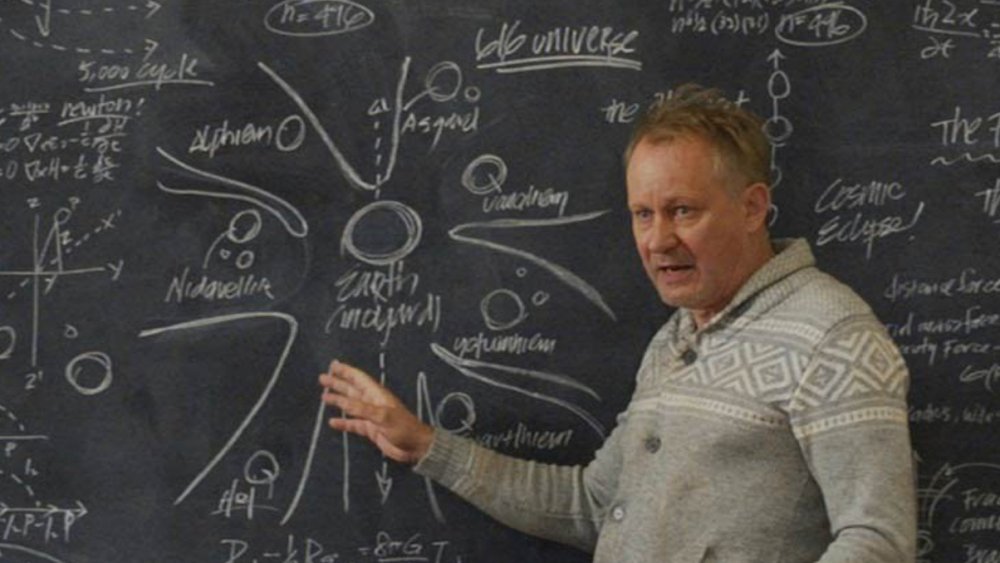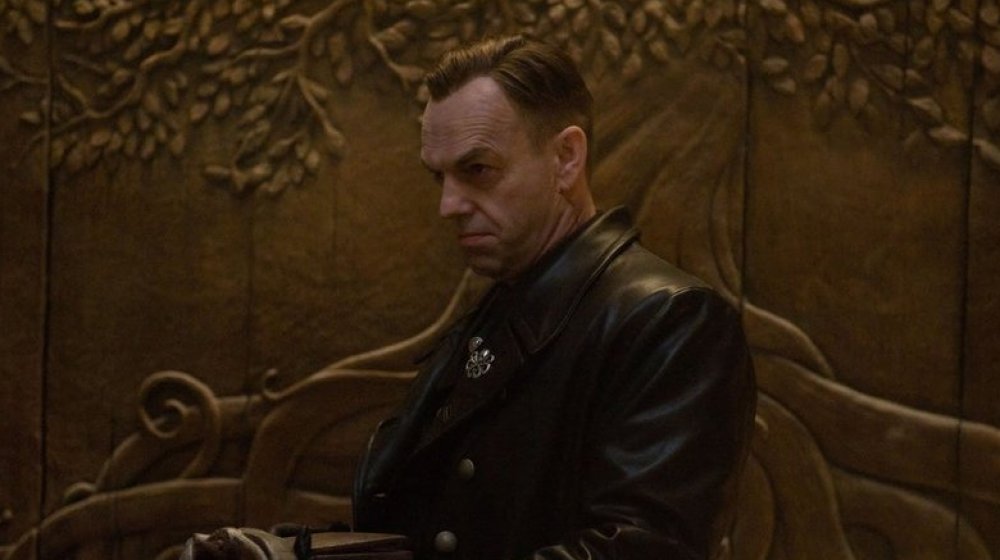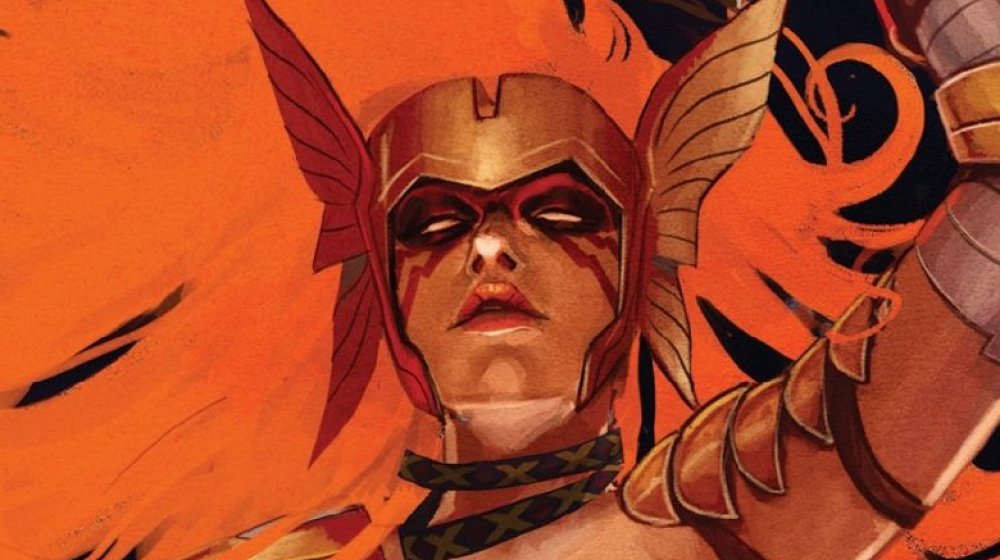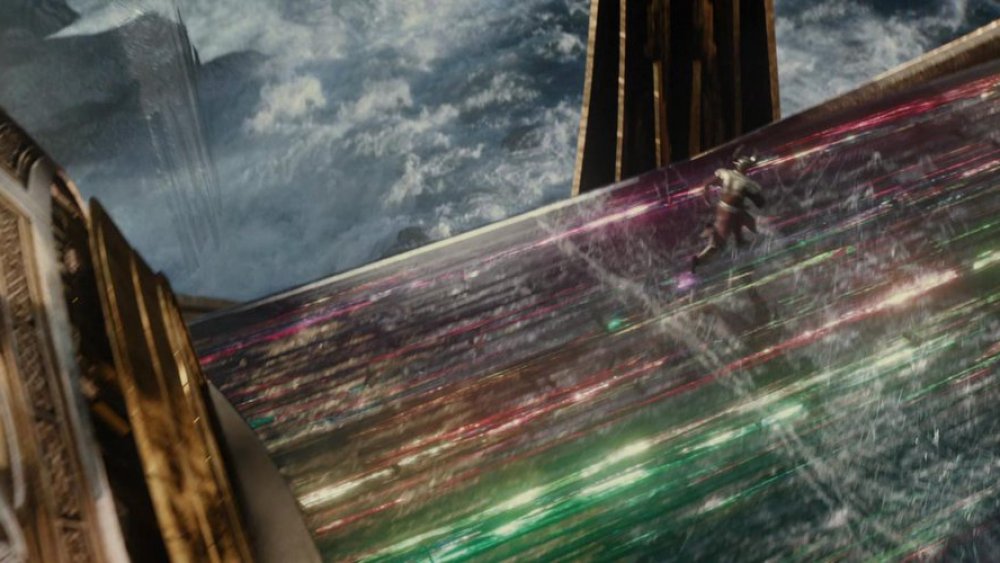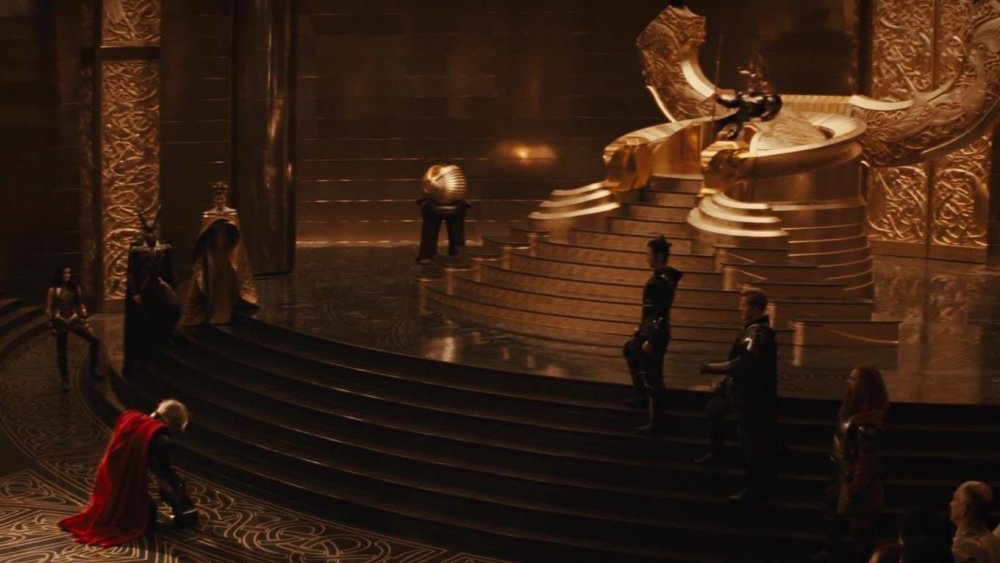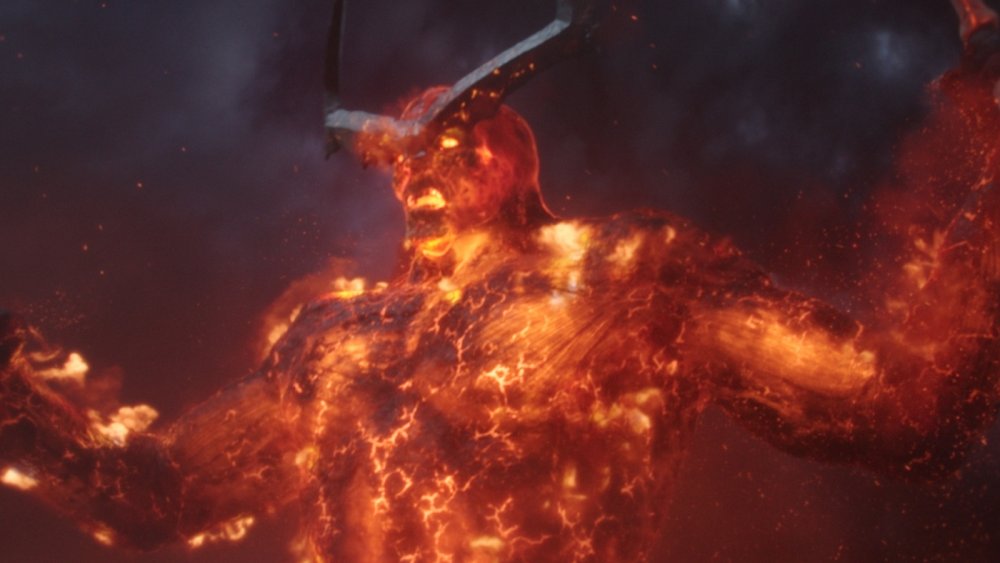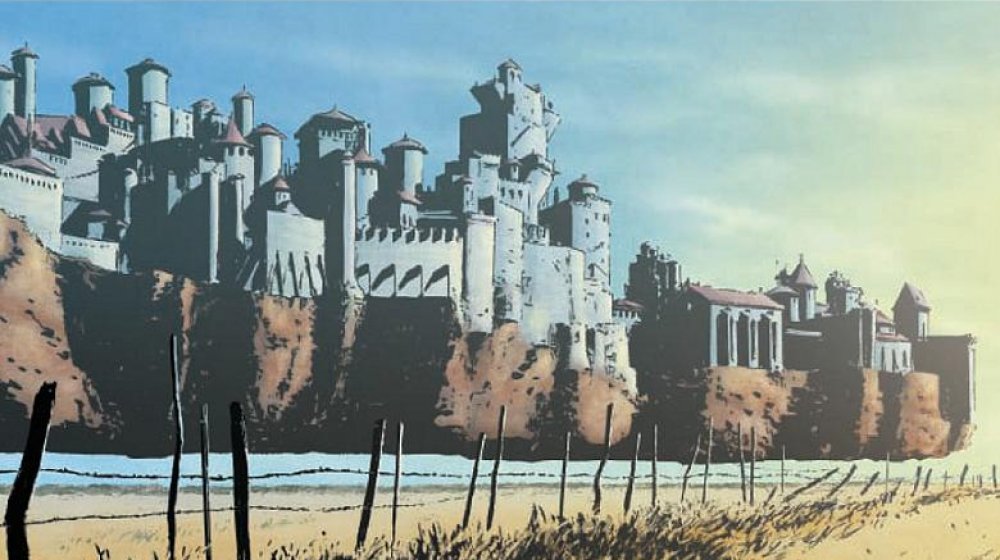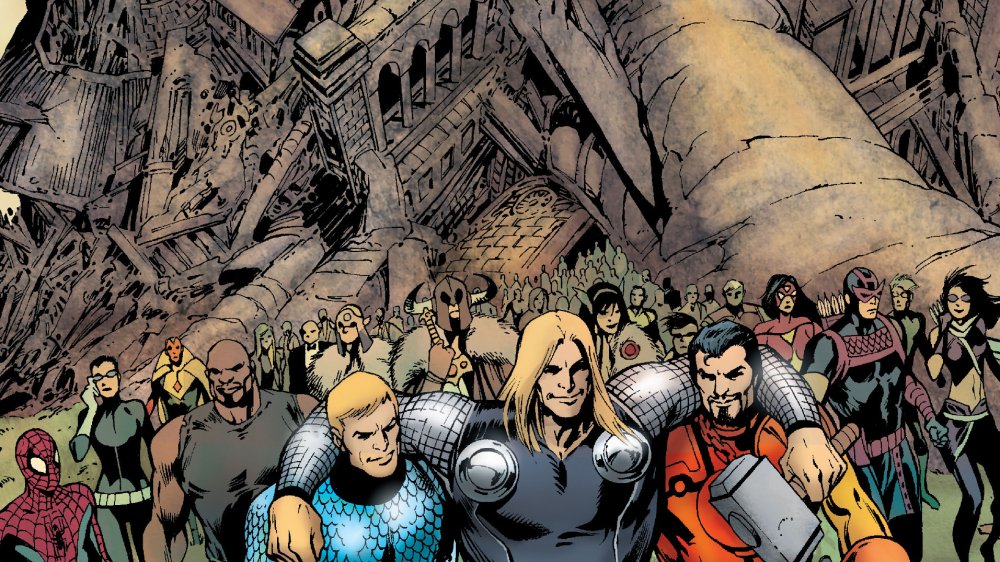The Untold Truth Of Marvel's Asgard
Asgard has been known to moviegoers since 2011's Thor as the home of the "Mightiest Avenger" and his troublesome adopted brother, Loki — very handsomely embodied by Chris Hemsworth and Tom Hiddleston, respectively. It's a glittering alien realm filled with beings so superior that they appear to be gods, and technology so advanced that it appears to be magic. Comic book fans, of course, know that Asgard has an even longer, richer history that dates back to its first introduction to the Marvel Universe in Journey Into Mystery #85, published in October of 1962.
Thanks to Marvel's numerous reboots and retcons, Asgard's history has evolved over the years, but one element has remained consistent: its roots in Norse mythology. Weaving characters and concepts like the demon Surtur and the rainbow bridge Bifrost into modern American superhero iconography, Stan Lee, Jack Kirby, and Larry Leiber created a fictional world like no other. Now for a closer look at the untold truth of Marvel's Asgard.
Myths and legends
In Norse myth, Asgard is the home of the gods, including the "all-father" Odin, his wife Frigg, and their sons Thor and Loki, as well as a host of others. From his golden throne in Asgard, Odin rules over the "nine worlds," including "Midgard" or "Earth." The nine worlds are connected by a mystical "world tree" called Yggdrasill, whose roots and branches stretch across the cosmos, though the gods tend to travel to Earth via a magical rainbow called the Bifrost.
When Stan Lee and his younger brother Larry Leiber introduced Asgard into comic books in a Thor adventure published in Journey into Mystery #85, the rainbow bridge and its guardian, the all-seeing Heimdall, were front and center. It wasn't until a year later, however, that the comic started cashing in on Thor's popularity with the spin-off feature Tales of Asgard, a passion project of artist Jack Kirby, which introduced more mythological elements, such as the Frost Giants and Surtur, and the concept of early humans mistaking the superpowered Asgardians for gods.
The version of Asgard introduced to the moviegoing mainstream in 2011 remains true to the comic books' depiction of a technologically advanced alien world filled with powerful beings who have been influencing human history since at least 965 A.D. during the Battle of Tonsberg, in which Odin saves Earth from the Frost Giants.
Asgard is not a place...
To the ancient Norse, Asgard was the fabled home of the gods, a beautiful city surrounded by walls to ward off attacks from Frost Giants. In Marvel's terminology, "Asgard" refers to Odin's gleaming royal city, as well as the region in which the city is located — just one realm among many on an asteroid roughly the size of the continental United States.
That asteroid, also called Asgard, is completely flat and does not revolve around a star or rotate on an axis, yet inexplicably maintains an atmosphere, gravity, and cycles of day and night. Equally unexplained is the mysterious force that keeps the waters of Asgard's seas from pouring over the edge of the disc-like world.
As the weird physics imply, Asgard is not located in our universe, but in a "pocket dimension," a region of space accessible only by special portals, such as the Bifrost bridge. This pocket dimension is one of the Nine Realms and is, simply enough, also called Asgard.
Asgard is a people
Marvel's Odin, Thor, Loki and friends are not gods, but members of a race so advanced that they inspire awe in the primitive humans they encounter. It makes sense, then, that the comic books defined Asgardians as superhuman in most respects.
All matter on Asgard is denser, heavier and stronger than any found on Earth, and that includes the Asgardians themselves. Their tougher skin and bones make them nearly impervious to physical harm, and their dense musculature gives them supernatural strength and speed, as Thor's frequent sidekicks, Lady Sif and the Warriors Three, can attest.
While they are not immortal, Asgardians heal rapidly and age slowly, and can prolong their lives even further by eating the "magical" Asgardian fruit known as the golden apples of Idunn. Just as Thor can control lightning and thunder, most Asgardians have the ability to manipulate cosmic energies. Typically, they use these powers to alter their appearances, or to teleport across great distances. Famed villain Doctor Doom once theorized that all Asgardians possess "the Odin Spark," an in-born source of their incredible powers.
Blue valkyrie is about to die
2017's Thor: Ragnarok introduced audiences to another Asgardian, Valkyrie. Played by Tessa Thompson, the MCU's Valkyrie is the hard-drinking last survivor of Odin's private guards. Betrayed, Valkyrie flees Asgard and ends up on Sakaar, where she goes by Scrapper 142, a sly reference to the character's first appearance in The Incredible Hulk #142. After running into Thor on Sakaar, she rejoins the fight to save her people, if not her world.
All of which is cool, but it isn't how the story of Asgard's greatest warrior played out in the comics. As in Norse myth, Marvel's "valkyrior" escort the souls of warriors killed in battle to the realms of the dead. When Asgard is banned from gathering souls from Earth, Valkyrie joins up with Enchantress for a life of adventure... but Enchantress betrays Valkyrie and traps her soul in a magic gem; for two years, she transfers the enslaved "valkyrie spirit" into a succession of host bodies.
In Defenders #107, Valkyrie is returned at last to her own body. For a while, anyway. She's killed in battle in issue #152, only to be resurrected in Doctor Strange, Sorcerer Supreme #3. More recently, in 2011's "Fear Itself" crossover storyline, Valkyrie comes to Earth to recruit a new group of human valkyrior. Per usual, this version of Valkyrie also meets a brutal death in 2019's "War of the Realms" storyline, beheaded by the dark elf Malekith.
Hopefully, Tessa will have better luck.
Magic and technology
In 2011's Thor, he explains extra-dimensional travel to his girlfriend, Jane Foster, saying, "Your ancestors called it magic, but you call it science. I come from a land where they are one and the same." The Marvel Cinematic Universe has taken the comic book's combination of mythology and superheroes to the next level, adding enough science to the fiction to suspend our disbelief.
A great example of this magic/science duality is the Bifrost, the rainbow bridge that joins Earth and Asgard. Natalie Portman's Foster refers to it as an "Einstein-Rosen Bridge," another name for a "wormhole." The Bifrost is depicted as a physical bridge made of dimension-warping crystals only when viewed from Asgard; meanwhile, from Earth's perspective, those traveling along the Bifrost appear to teleport into our world, accompanied by a blaze of rainbow-colored light which leaves a "rune of the Bifrost" burned into the landing surface.
Similarly, in 2011's Captain America: First Avenger, the Red Skull retrieves the Cosmic Cube from a church in Tonsberg, Norway, where it's hidden behind a carving of Yggdrasil, the world tree that unites the Nine Realms, shown as a symbol of myth. In 2013's Thor: The Dark World, scientist Erik Selvig tries to explain the concept of multiple universes by drawing a map of nine neighboring dimensions... that matches the branches and roots of Ygdrassil. As sci-fi author Arthur C. Clarke once wrote, "Any sufficiently advanced technology is indistinguishable from magic."
I did Nazi that coming
Let's back up and talk about that scene from Captain America: First Avenger again, in which Johann Schmidt, also known as the Red Skull, locates the Cosmic Cube hidden behind a carving of Yggdrasil. Schmidt is the leader of Hydra, a breakaway group within the Nazi party that just doesn't find Hitler extreme enough. A Nazi villain makes perfect sense in a Captain America story, but what's this crossover about?
Hitler was famously obsessed with the occult and mythology. That's why fictional archeologist Indiana Jones so frequently finds himself punching Nazi treasure hunters. The Red Skull himself references Hitler's obsession — and possibly Raiders of the Lost Ark, as well — at the beginning of the scene with the line, "Let the Führer dig for trinkets in the desert." Nazis, both old and Neo-, have long co-opted Norse symbolism for their own purposes. In fact, during World War II, the curiously named Nazi officer Wilhelm Kube wanted to purge the city of Minsk and rename it Asgard.
The Nine Realms... plus one
Norse myth refers to the existence of "nine worlds." Marvel's Nine Realms are based directly on these worlds, and many have been seen in the MCU. There's Asgard, the home of Thor, and Jotenheim, the home of the Frost Giants. Then there's Svartalfheim, aka the dark world of Thor: The Dark World, the film that also gave us glimpses of Vanaheim, where Thor battled the Marauders, and Muspelheim, home of Surtur. The realm of Nidavellir is known in the MCU as the home of giant Peter Dinklage, and Niflheim is where Cate Blanchett's Hela spent her banishment. And there's Midgard, of course, also known as Earth. A ninth realm, Alfheim, has been mentioned but not yet explored.
Unmentioned in the MCU, however, is a tenth realm: Heven. Introduced in the 2014 miniseries Original Sin, Heven is a realm inhabited by angels who Odin employs to protect humanity (sort of.) When the Queen of Angels betrays Odin and seemingly kills his newborn daughter, Odin cuts off Heven from the rest of the realms as a punishment. Little does Odin know that his daughter, renamed Angela, is alive and well in Heven.
In a strange bit of art imitating life, Angela was a character originally created by Neil Gaiman for Image Comic's Spawn. After winning custody of his "lost child" in a battle with co-creator Todd McFarlane, Gaiman brought Angela to Marvel, where she found new life in Thor's storyline.
Bridge and Tunnel
In the MCU, travel from Asgard to the rest of the Nine Realms requires a visit to the all-seeing and kinda judgey Heimdall, guardian of the rainbow bridge. Without the help of Heimdall and his cool sword/key Hofund, even Odin himself has a hard time crossing inter-dimensional space. In the comics, however, the Bifrost is merely the most reliable portal to Midgard, or Earth. The rest of the realms are connected to Asgard by so many planar nexuses that their geographies at times seem physically connected.
The Nine Realms appear to connect to other dimensions as well. In 1965's Journey into Mystery Annual #1, Thor and Loki discover a passage between Jotunheim, the realm of the Frost Giants, and Mount Olympus, home of the pantheon of Greek gods. Thor meets Hercules, his future Avengers teammate, and they have an increasingly aggro contest to see who is mightier until their dads come and break it up. Not gonna lie, it's a little Step Brothers.
Odin is not the first ruler of Asgard
Stories of Asgard are filled with faux-Shakespearean drama about royal lineage. The plot of 2011's Thor — directed by Royal Shakespeare Company veteran Kenneth Branagh — was about a prince learning what it takes to be a wise ruler. Every subsequent Thor movie has involved Loki's attempts to usurp the throne. With Odin's death in 2017's Thor: Ragnarok, his long rule finally ends... but Asgard itself ends not long after that. (Kinda. We'll get to that.) While this may give the impression that the story of Asgard is all about Odin's reign, he is not its first king.
The first king of Asgard was Odin's grandfather, Buri. Though Buri's never seen in the MCU, Odin name-checks him in 2011's Thor. Buri isn't given much more love in the comics, either. He makes a brief appearance in Journey Into Mystery #97, emerging full grown from ice that melted because it was licked by a cosmic cow. (Why hasn't this been included in the MCU? Hmmm.)
Buri was the first king of Asgard, followed by his son Bor, seen in a flashback in 2013's Thor: The Dark World battling the Dark Elves. Bor rests in peace in the MCU, but he meets a more tragic end in the comics. Resurrected by his adopted grandson Loki, Bor is tricked into attacking Earth. Thor is forced to kill Bor, which results in his banishment.
Ragnarok-n-Roll
Central to Norse mythology is the concept of "ragnarok," or "the twilight of the gods," in which the gods die in battle, Asgard falls, and the Earth is consumed by a flood, only to be reborn fresh to start all over again. The original reboot, you might say. It was totally appropriate, then, that Marvel breathed new life into the gasping Thor franchise with 2017's Thor: Ragnarok. With the help of the brilliant Taika Waititi, Ragnarok re-imagined the character's look, fighting style and, most importantly, his tone, rescuing Thor's brand even as his world was ending.
The "Ragnarok" of the MCU sees Asgard fall when Thor is forced to free the demon Surtur to end his sister Hela's evil reign. Just as Thor foresees in that weird cave/hot tub scene in 2015's Avengers; Age of Ultron, Asgard is left a smoking ruin, its people fleeing to the stars. Marvel's comics have seen Asgard fall and rise, with the first cycle of Ragnarok beginning in Thor #274 back in August of 1978. Four issues later, Thor manages to delay Asgard's fall by accepting banishment to Earth. His effort holds off Ragnarok until 1998 and the publication of Thor Vol. 2 #80 – 85, in which Loki creates enough copies of the hammer Mjolnir to equip an army and bring down Asgard at last.
Coming to America (or Norway, depending)
After the destruction of Asgard in the climactic scenes of Thor: Ragnarok, the Asgardians flee and take to the stars. While those traveling with Thor meet an equally terrible fate at the hands of Thanos, the remaining few survivors of this double-tragedy resettle on Earth. They create a "New Asgard" in Tonsberg, Norway, a town repeatedly visited by supernatural beings that still manages to be rather quaint.
The Asgardians of the comics also find a new home on Earth after their own Ragnarok. In Fantastic Four #536, Thor builds the City of Asgard, a massive complex of castle walls and towering spires hovering several feet above the ground, outside of Broxton, Oklahoma. This version of Asgard would also "fall," slowly and secretly being purchased and rendered uninhabitable by Roxxon, an evil corporation frequently working behind the scenes of some of the Marvel Universe's shadiest business. The Asgardians depart but leave behind a magically eternal fruit tree and fountain.
The other end of the world
Asgard's final fall began in the 2009 miniseries Siege, by Brian Michael Bendis and Olivier Coipel. The City of Asgard — the one hovering outside of Broxton, Oklahoma — is attacked by Norman Osborn, who has set aside his Green Goblin identity to provide a respectable face for his cabal of villains, including Loki, Doctor Doom, and Taskmaster.
Seeing Asgard as the last holdout in his attempt to conquer America, Osborn tries to convince the President to let his "Dark Avengers" team invade. When the President initially refuses, Osborn manufactures a devastating attack on Soldier Field in Chicago, and then blames the civilian casualties on Thor's old Asgardian pal, Volstagg.
Osborn manipulates public sentiment by offering exclusive broadcast rights to the Dark Avengers' invasion of Asgard to a conservative TV host who paints the Asgardians as an alien threat. Osborn loses the support of both the public and his own team, however, when the stress of battle causes his insane Green Goblin persona to resurface. While Asgard manages to survive Siege, Marvel's What If...? #200 asks the question, "What if Osborn has won the siege of Asgard?" The short answer: the end of the universe. Ragnarok.
